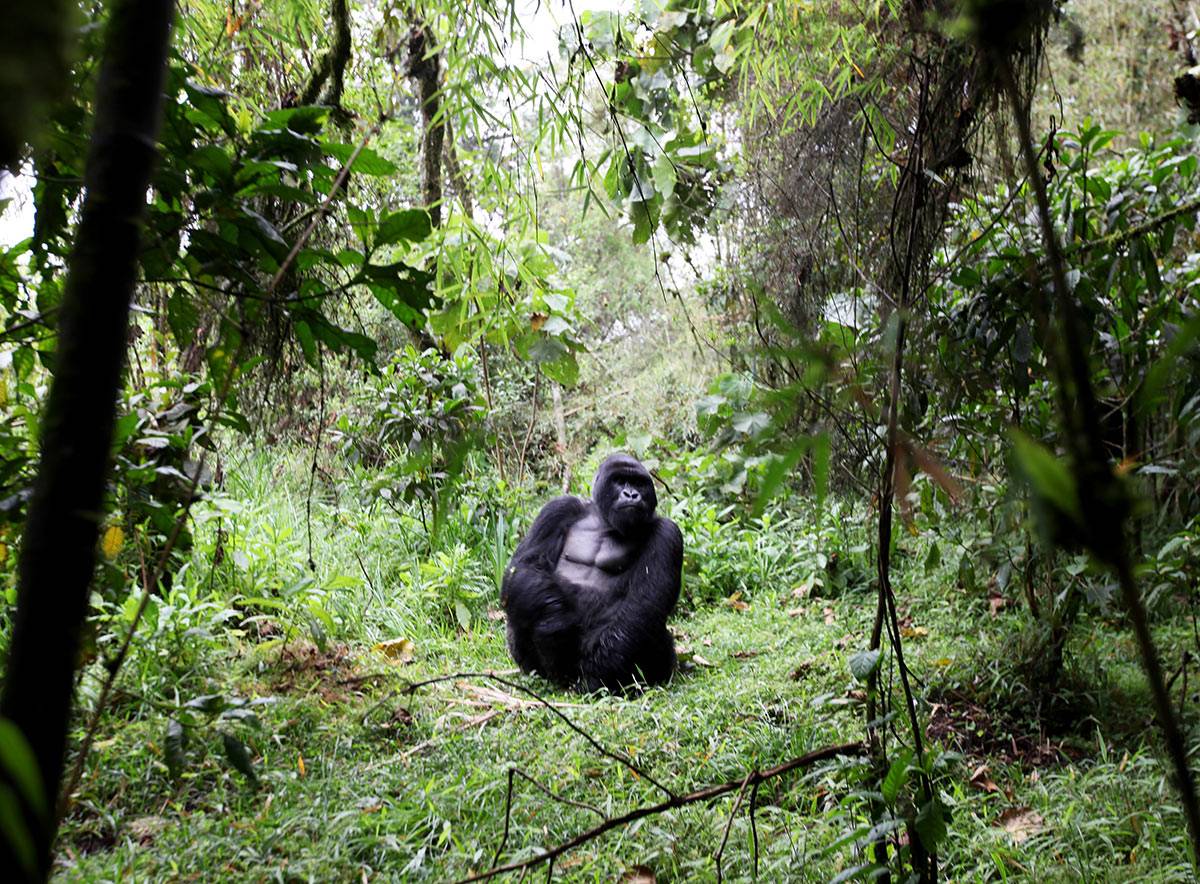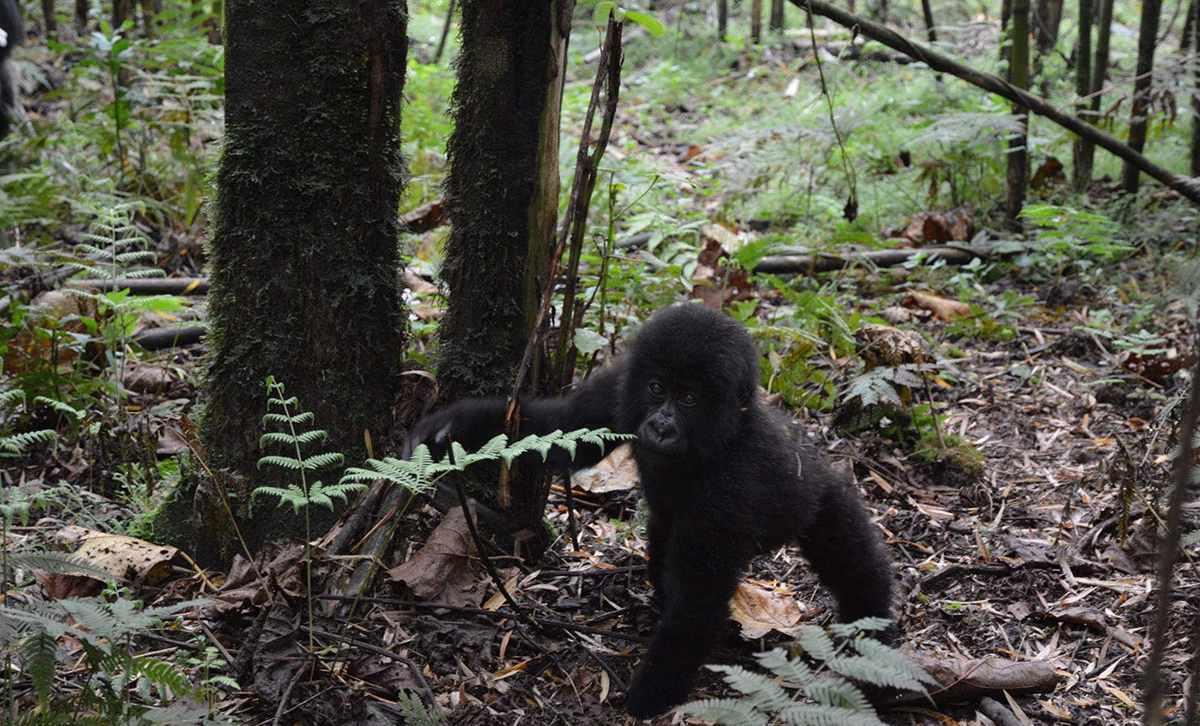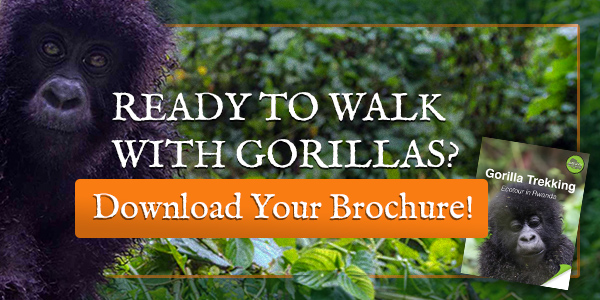Gorilla Trekking in Rwanda vs. Uganda

Less than 900 mountain gorillas exist, and they are only found in 3 places on earth, Rwanda, Uganda, and the Democratic Republic of Congo. Since the D.R.C. is not generally safe for travel at this time, most people end up choosing between the other options. Deciding weather to go gorilla trekking in Rwanda vs. Uganda is the first step you’ll take when planning a trip to see these endangered primates.
The most popular destinations for visiting the gorillas are Bwindi Impenetrable National Park in Uganda, and Volcanoes National Park in Rwanda. In both parks, the overall trekking logistics are similar. Several gorilla families have been habituated and are comfortable with human interaction. Pay for a permit, and a trained guide will take a small group deep into the jungle to search for the gorillas. To keep the gorilla families from getting overwhelmed, only one group gets to visit each family per day and visits are limited to 1 hour. This hour is truly incredible and often described as one of the best experiences in a lifetime for many travelers. In order to cover all the bases, guides warn that seeing the gorillas is not guaranteed, but highly likely. Ultimately, the goal of gorilla trekking in both countries is to promote conservation of the gorilla’s environment and increase their population.
With the general information out of the way, what’s so different about gorilla trekking in Rwanda vs. Uganda? We’ve compiled the highlights and the lowlights of what each country offers:
Rwanda Highlights
- Volcanoes National Park is home to 10 mountain gorilla families, the largest number of habituated groups in the world. Therefore, it’s easier to get permits to see them.
- Gorilla trekking has been a Rwanda’s largest tourist attraction for many years. Tour guides are very experienced, and the overall experience is more established.
- Importantly, travellers will spend less time in-transit when visiting Rwanda. Most travellers fly into Kigali, which is only a 2.5 hour drive (on paved roads!) from the trekking location.
- Travellers report that seeing and photographing the gorillas is easier in Volcanoes, because the jungle vegetation is more open, making it easier to get a clear shot.
Rwanda Lowlights
- If you’re looking for a traditional African safari experience, Rwanda may not be the best choice. It doesn’t include the “big 5 game” animals that most people associate with Africa. If a traditional safari is on your bucket list, travelling from Rwanda to Tanzania is a breeze. The “big five” can be found in Tanzania’s Serengeti, one of the best wildlife parks in the world.
- Permit prices are more costly in Volcanoes National Park at $750 each. However, trekking with Gondwana includes the park permit; in the trip price; not too shabby!
Uganda Highlights
- About half of the world’s remaining mountain gorillas live in Uganda’s Bwindi Impenetrable National Park. There are 4 habituated families that can be visited on treks.
- Permit costs are a bit more affordable in Bwindi, at $600 during the high season, and $450 during the low season of April, May and November, due to unfavorable weather.
- Seeking an African safari in addition to a gorilla trek? If so, Uganda is probably the best choice. In addition to vast biodiversity, Uganda is home to the “big 5 game” animals.
- Bwindi National Park is a UNESCO world heritage site in their words, a “conservation frontline as an isolated forest of outstanding biological richness.”
Uganda Lowlights
- Bwindi is very remote, and travel to the park can be difficult. Bad roads lead to a difficult, long journey from the major airports to the park. Prepare to spend a full day in the car.
- The forest isn’t named “Impenetrable” for nothing! Vegetation in the park is dense, and travellers report that hikes can be challenging and getting clear photos can be difficult.
Clearly, there’s a lot to consider between Rwanda vs. Uganda. But in Gondwana’s opinion, trekking in Volcanoes National Park offers a more simple, rewarding trip. As an ecotourism company offering trips to Rwanda, we can’t help but play favorites. However, research is half the battle when planning a trip. Choose the destination that fits your travel goals, budget, and comfort zone. Happy trekking!
10 Tips for Photographers Who Trek With Gorillas
Photographing gorillas can be an exhilarating and rewarding experience, but it requires careful planning and consideration. Here are some tips to help you capture stunning images of these magnificent creatures:
- Respect Their Space: Gorillas are wild animals, and it’s essential to maintain a safe distance to avoid disturbing them or causing stress. Follow the guidelines provided by your guides or park rangers to ensure both your safety and the well-being of the gorillas.
- Use the Right Gear: Invest in a good quality DSLR or mirrorless camera with a telephoto lens. A telephoto lens with a focal length of at least 200mm is recommended to capture close-up shots while maintaining a safe distance.
- Bring Spare Batteries and Memory Cards: Gorilla trekking can be physically demanding, and you may not have easy access to charging facilities. Make sure to carry extra batteries and memory cards to avoid running out of power or storage space.
- Adjust Your Camera Settings: Set your camera to continuous shooting mode to capture rapid movements. Use a wide aperture (low f-stop) to achieve a shallow depth of field and blur the background, making your subject stand out. Adjust your ISO and shutter speed according to the lighting conditions.
- Be Patient and Observant: Gorillas are unpredictable animals, and capturing the perfect shot may require patience and perseverance. Take your time to observe their behavior and anticipate their movements to capture candid moments.
- Focus on the Eyes: The eyes are the window to the soul, and capturing the gorilla’s eyes can create powerful and emotive photographs. Use the autofocus mode to ensure sharp focus on the eyes, and try to make eye contact with your subjects.
- Pay Attention to Composition: Experiment with different angles and compositions to create visually appealing images. Consider using the rule of thirds, leading lines, and framing techniques to add interest to your photographs.
- Respect the Natural Environment: Avoid using flash photography, as it can startle or disturb the gorillas. Instead, rely on natural light or use a low-powered flashlight if necessary. Be mindful of your surroundings and avoid trampling vegetation or making loud noises.
- Capture the Context: Don’t just focus on close-up portraits of the gorillas. Try to capture their natural habitat and behavior to tell a more comprehensive story. Include elements such as trees, foliage, and other wildlife to provide context to your images.
- Be Prepared for the Elements: Gorilla trekking often takes place in remote and rugged terrain, so be prepared for challenging weather conditions. Bring waterproof camera gear and protective clothing to ensure your equipment stays dry and you remain comfortable throughout the trek.
Remember to prioritize the well-being of the gorillas and follow the guidelines provided by your guides or park rangers at all times. By respecting these magnificent creatures and their habitat, you can create beautiful photographs while contributing to their conservation and protection.

Adorable gorilla in Rwanda



